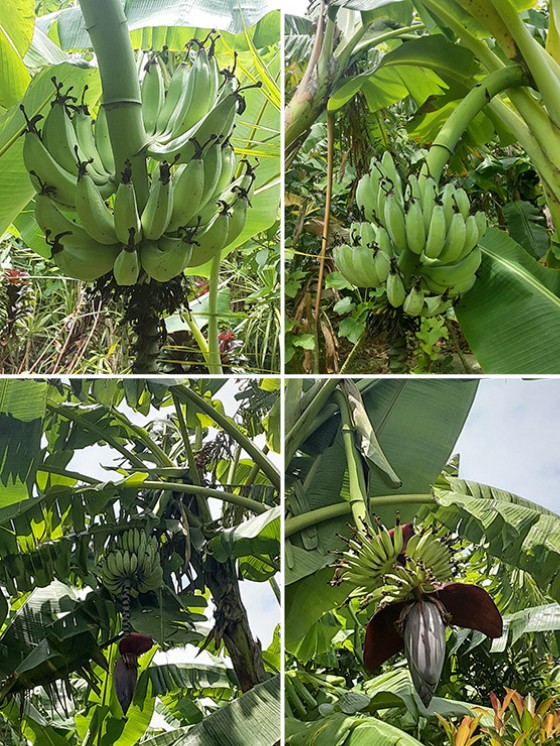
Since some eight years ago the Ryukyu Islands have had functioning rectification barriers, and since then no deadly typhoons have hit the islands. Before that, once or twice each year, from mid-July to September, strong typhoons made landfall, devastating tall fruit trees and other varieties, making it impossible to raise bananas in Okinawa as a regularly cultivated agricultural crop.
However, now there is an abundant harvest of bananas everywhere in Okinawa, and industrial development of them as a crop is possible. In response to the corona pandemic, the Kekkai barrier’s power was increased, and since then most viruses have disappeared. Papayas, for example, which were difficult to cultivate for long periods due to viral infections, are now completely virus-free, and older trees that had been infected with the virus in the past are now growing normally.
Flower cultivation used to require intensive management, but now it is possible to create magnificent flower beds without special handling or care. Flowers are blooming beautifully not only at schools, but also in public squares, and perennials such as Madagascar periwinkle, Pentas, Angelonia, and others are flowering all year round.
Naturally, the introduction of a variety of flowers will enhance the overall strength of the ecosystem.
In the outer areas of the Blue-Sky Palace, fruit trees such as guava, Java apple, shikuwasa, Hirami lemon (small tangerine oranges), pitanga, Brazilian cherry, and acerola are bearing abundant fruit while also functioning as windbreaks. We have also planted dracaena, croton, hibiscus, etc., in various spots to liven up the garden by adding more color.
Since this is all no-tillage cultivation, we can plant anything anywhere, so we also try to plant flowers to aid in weed control. We have just begun doing this, but below I’d like to show some of the flowers on our office veranda and in the field.
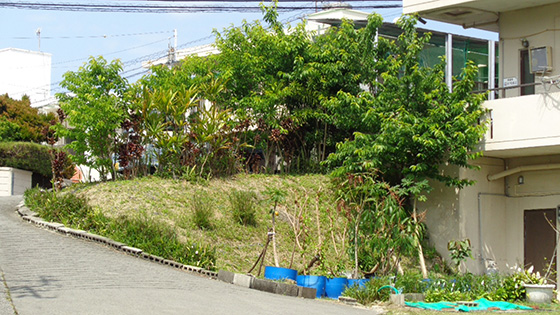
The cherry tree outside has grown bigger.
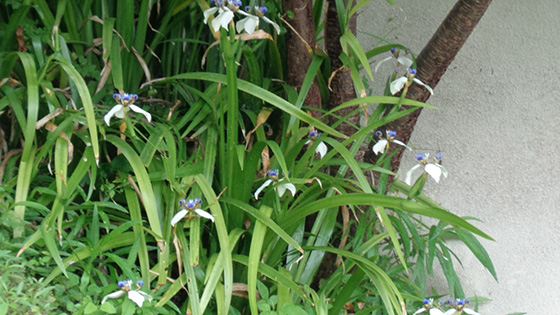
Walking iris blooming under the cherry tree.
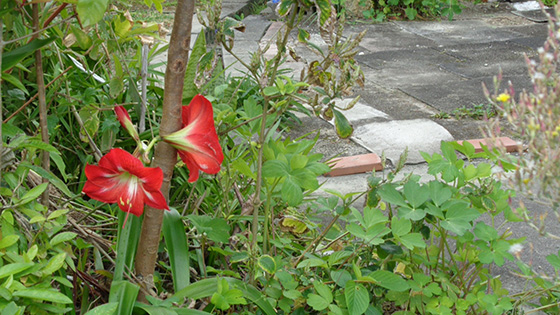
Amaryllis blooming among the Peucedanum japonicum (coastal hogfennel).
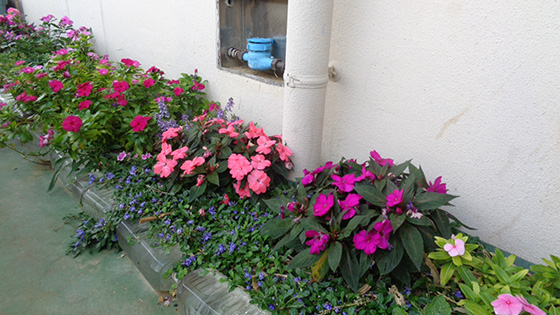
A flower bed on the veranda of the 3rd floor office. The soil is 5 to 7 cm deep.
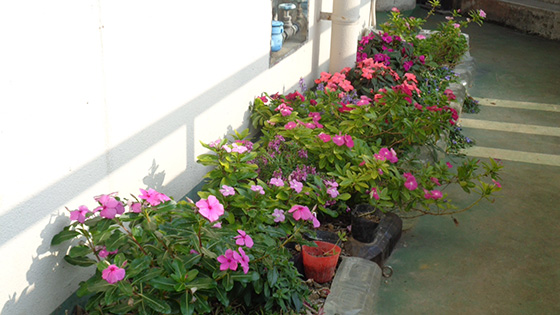
The veranda on the third floor.
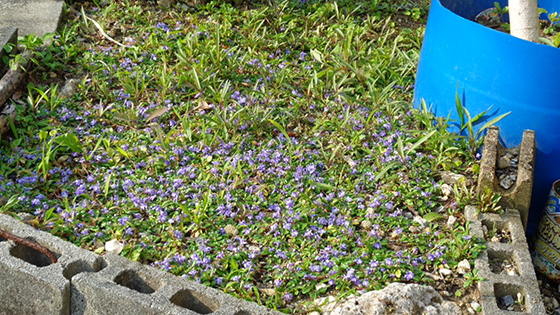
Himekiranso (Lamiaceae) at the entrance
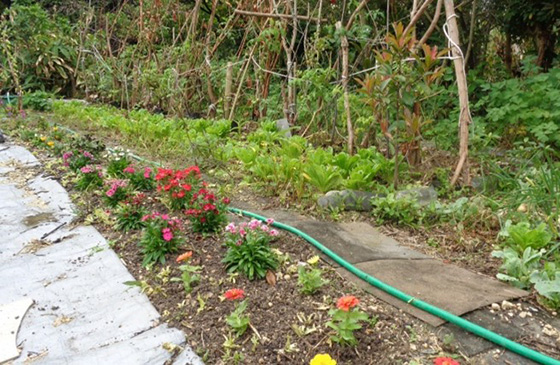
Dianthus, zinnias, gazania, etc. in front of vegetables.
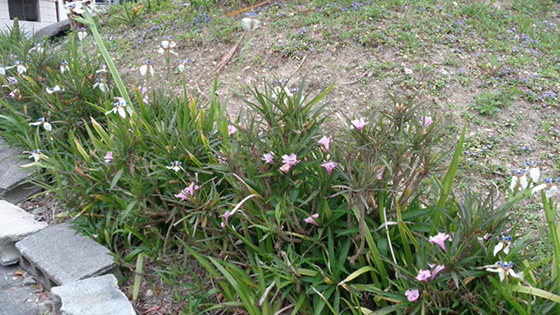
Dwarf lilacs at the entrance
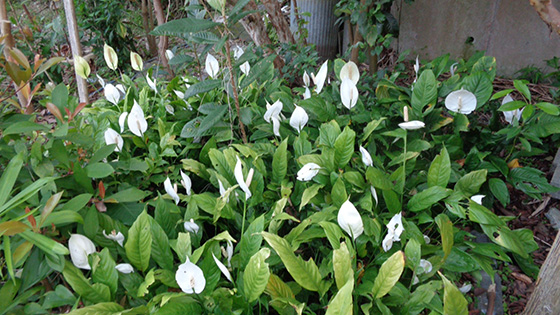
Spathiphyllum under the guava
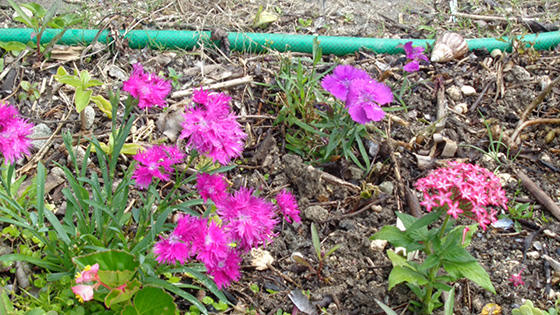
Dianthus and Pentas on the corner
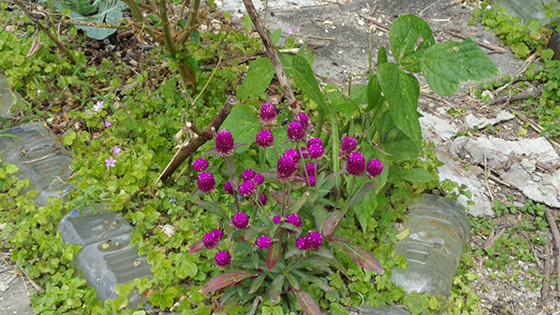
Globe amaranth on the corner
Sightings of whales and dolphins in Tokyo Bay and Osaka Bay, and of finless porpoises in Nagoya Harbor, etc. have been a hot topic recently, and all are places where EM has been applied and become established for many years. Makiminato fishing port, where a dolphin was sighted, is also a port where EM from the dam at the University of the Ryukyus campus flows down into the Makiminato coast.
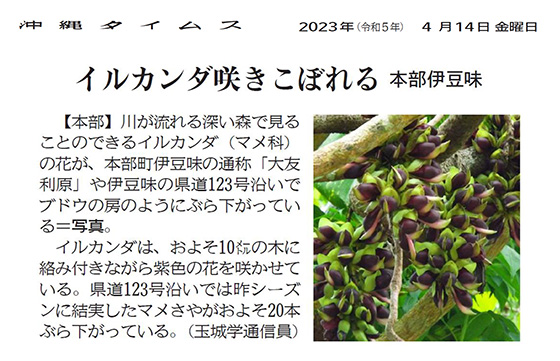
Okinawa Times, Friday, April 14, 2023
Grape-like clusters of Irukanda (leguminous) flowers are found in the deep forest where the Motobu River flows, in Izumi, Motobu Town, commonly known as Otomo Rigen, and also along Prefectural Road 123 in Izumi, Motobu Town (see photo). Irukanda are purple flowers that wrap around the 10 meter high tree. Along Prefectural Route 123, about 20 bean pods that bore fruit last season are hanging down. (Reported by Manabu Tamaki)
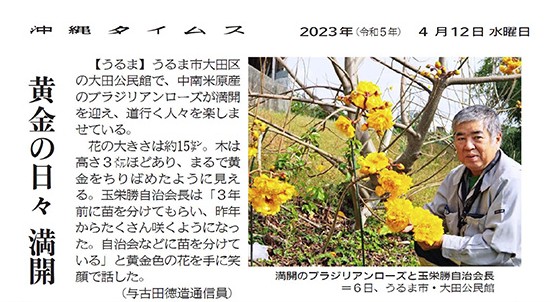
Brazilian roses in full bloom and community head, Masaru Tamae at the Ota Community Center, Uruma City, on March 6th.
Okinawa Times, Wednesday, April 12, 2023
Blooming flowers in Uruma Enjoying the blooming flowers along the road Brazilian Rose trees, native to Central and South America, are in full bloom at the Ota Community Center in Ota-ku, Uruma City, delighting passers-by. The flowers are about 15 cm in size, and the tree itself is about 3 meters tall and looks like it is studded with gold. Mr. Masaru Tamae, the head of the community association remarked that, “I received the seedlings three years ago, and since last year so many flowers have been blooming. I have been sharing the seedlings with neighborhood associations.” He had a big smile as he held the golden flowers in his hands. (Reported by Tokuzo Yokota)
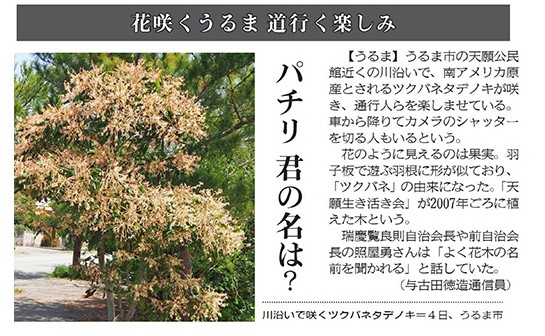
Triplaris americana blooming along the river in Uruma City on April 4th.
Okinawa Times, Wednesday, April 12, 2023
Flowers blossoming in Uruma
Enjoying the Blooming flowers while passing along the road
Along the river near Tengan Community Center in Uruma City, Tsukubane Tadenoki, Triplaris americana, which is said to be native to South America, is blooming now and delighting the eyes of passersby. Some people even get out of their cars and snap photos of the flowers. But what looks like a flower is actually a fruit. The shape of the fruit resembles the feathers on a battledore shuttlecock, which is the origin of their name, “tsukubane,” (a feathery, colorful shuttlecock). The tree was planted around 2007 by the Tengan Ikiiki Kai. Yoshinori Zukeran, the neighborhood association president, and Isamu Teruya, the former president said, “We are often asked the name of this flowering tree.” (Reported by Tokuzo Yokota)
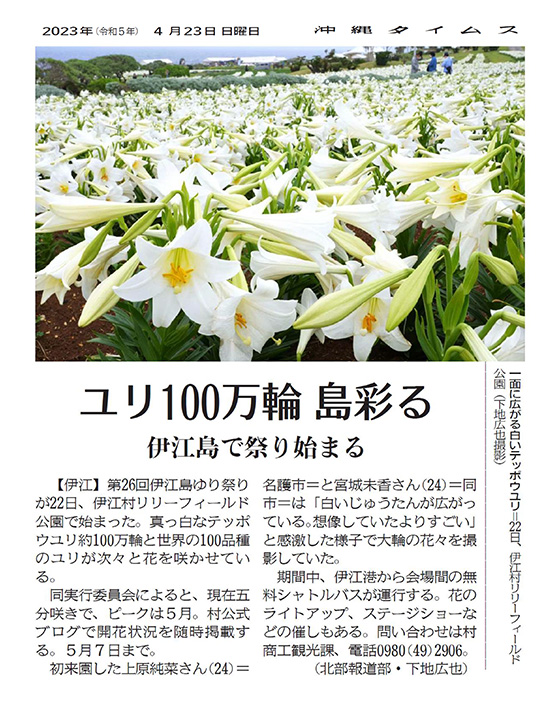
White easter Lilies spreading all over the village on March 22 at Lily Field Park in Ie Village (Photo by Hiroya Shimoji)
Okinawa Times, Sunday, April 23, 2023
Festival Begins on Ie Island
The 26th Ie Island Lily Festival began on April 22nd at Lily Field Park in Ie Village. About one million pure white easter lilies and 100 varieties of lilies from around the world are blooming one after another.
According to the committee in charge of the festival, the lilies are currently in half bloom and will peak in May. From now until May 7th the village’s official blog will post information on the flowers’ blossoming status.
Junna Uehara, 24 and Mika Miyagi, 24, both from Nago City, who visited the park for the first time, said, “The white carpet of flowers is more amazing than I’d imagined,” and they excitedly kept on photographing the large flowers.
During the festival, free shuttle buses will run from Ie Port to the venue. There are also events such as illumination of the flowers and stage shows. For inquiries, please contact the Village Commerce, Industry and Tourism Division at 0980 (49) 2906. (Hiroya Shimoji, Northern Press Department)
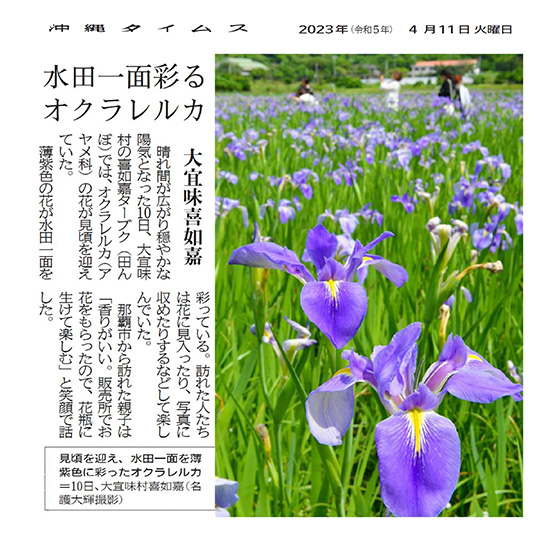
Now in its best season to view the Okulaleluka, which have added a pale purple color to the entire paddy field (April 10th in Kijoka, Ogimi Village). (Photo by Daiki Nago)
Okinawa Times, Sunday, April 11, 2023
Iris (Okulaleluka) Colors the Rice Fields
On April 10th, a calm and sunny day, Iris (Okulaleluka) flowers were at their best in the rice paddies of Kijoka Tabuku (rice fields) in Ogimi Village. Light purple flowers decorated the rice paddies, and visitors enjoyed seeing them and taking pictures. A parent and child were visiting from Naha City and the mother said, happily, that, “The fragrance is very nice. I got some flowers at the sales counter, so I’m going to enjoy arranging them in a vase.”
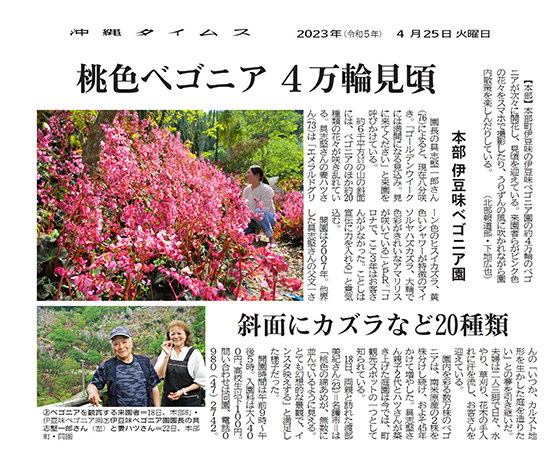
Above: Visitors admiring the begonias at the Izumi Begonia Garden in Motobu Town on April 18th. Below: Mr. Ichiro Gushiken (left), the director of the Izumi Begonia Garden, and his wife, Hatsu, at the garden in Motobu Town on April 22nd.
Okinawa Times Tuesday, April 25, 2023
About 40,000 begonias in the Izumi Begonia Garden in Izumi, Motobu Town, Okinawa Prefecture have blossomed one after another and are now at their peak. Visitors are enjoying taking pictures of the pink flowers with their cell phones and strolling around the park while feeling the Urizun, early summer, breeze. (Hiroya Shimoji, Northern Press Department)
According to Mr. Ichiro Gushiken, 76, the director of the garden, the trees are currently about eighty percent in bloom. “The flowers are expected to be in full bloom during Golden Week,” he added, “so please come and enjoy them.”
A mountain slope of about 6,000 square meters is covered with begonias and about twenty other types of flowers, also in full bloom. Mr. Gushiken’s wife, Hatsu, 73, actively promotes the flowers, saying, “There are emerald green color Jade vine, yellow and brick color Thunbergia Mysorensis, and large, colorful amaryllis are now blooming.” She explained that “Due to the Corona pandemic we have had very few visitors for the last three years. We will more focus on advertising the garden this year.”
This garden opened its gates in 2007. Mr. Gushiken inherited the dream of his late father, Bunichi, who said, “Someday, I want to create a garden that makes the most of the karst topography.” The couple works very hard together everyday watering, mowing, and taking care of the flowers and trees to welcome visitors.
The garden began with two plants’ roots native to South America that were divided many times and which, over 45 years, grew to tens of thousands of begonia plants that decorate the garden. The garden, built by two generations of Gushikens, as well as Hatsu, is now known as one of the town’s sightseeing spots.
Miki Watabe, 23, from Nago City, who visited with her parents on April 18th, said, “It looks like countless rows of pink cotton candy. It’s fantastic view and looks great on Instagram.”
The garden is open from 9:00 am to 5:00 pm. Admission is 400 yen for adults and 100 yen for high school students and those younger. For inquiries, please call the park at 0980 (47) 2742.

A dolphin that got lost in Makiminato fishing port in Urasoe on April 23rd.
A False Killer Whale, separated from its parents?
Fishermen said, “We never expected to see one here.”
On the 23rd, a wild dolphin between 2 and 2.5 meters in length wandered into Makiminato fishing port in Urasoe City. A staff member of the Okinawa Churashima Foundation rushed to the spot where it was sighted to confirm that it was an Okigondo, a false killer whale, a type of cetacean.
According to witnesses, the dolphin appeared before noon and stayed in the fishing port until 4:00 pm. According to the Foundation, false killer whales live in groups off the coast of the main Island of Okinawa and surrounding areas, and males can grow to 6 meters and females up to 4 meters in length. The dolphin that wandered into the area was of unknown gender and is believed to be less than two years old based on its length.
Ryo Nakasone of the Marine Mammal Division of the foundation, who confirmed the dolphin at the site, speculated that it is quite possible that the dolphin wandered into the fishing port after getting separated from its parents. “These kinds of dolphins are normally found well offshore and rarely stray into fishing ports,” he said. “We hope this one will return to the offshore area on its own.”
Kazuma Tokugen, 30, from Urasoe City, who was eating at a restaurant near a fishing port, said, excitedly, “I’ve never seen a wild dolphin, and am so surprised to see them in a place like this.” Masayoshi Nakazato, 61, a fisherman for more than twenty years, said, “This is the first time a dolphin has come into the port. I wonder if it will be safe tomorrow with so many boats coming and going.”
(Nagateru Tamanaha, Social Affairs Department)
Read the original Japanese message at the link below.
2023.7.10 Updated.